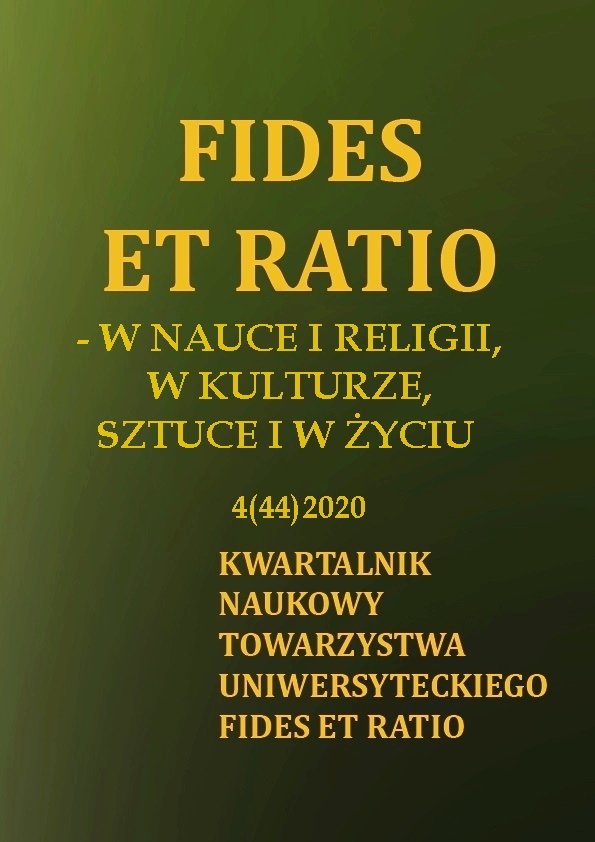Abstract
The article reflects on the symbolic meaning of emptiness rooted in Christian doctrine, philosophy and religiosity on the basis of photographs presenting the message from religious celebrations in St. Peter in Rome during the spring Covid 19 pandemic incidence peak; these photos entered the wide circulation in the news media around the world. In Christian doctrine, emptiness is primarily related to the mystery of Christ's empty tomb, that is, the resurrection; thus it takes on an ambivalent meaning – it manifests the "presence of the absent". A similar phenomenon characterizes the essence of images (image anthropology). Not without significance in this context is the ambivalence of the desert experience, which in the eyes of mystics allowed for a spiritual relationship with God, as well as the "holy sense of absence", as a kind of "dark night" that Simone Weil wrote about. Thanks to their rich semantics, the above-mentioned photographs not only evoke a sense of the threat to life due to the Covid 19 pandemic, but also force deeper reflection, delving into one's own self in search of the true meaning of life, self-sacrifice, social solidarity. Finally, they allow us to conclude that voidness is not only a neutral space for relieving tension, but a nodal point where potentiality and becoming intertwine, where deficiency and completeness, identity and disaccord.
References
Belting, H. (2007). Antropologia obrazu. Szkice do nauki o obrazie, tłum. M. Bryl, Kraków: TAiWPN Universitas.
Brejdak, J. (2016). Logos komunikującego milczenia, Ethos, 1, (21-35).
Buber, M. (1992). Dialog w: Ja i Ty. Wybór pism filozoficznych,, wybór i tłum. J. Doktór, Warszawa: IW PAX.
Calvino, I. (1996). Wykłady amerykańskie, tłum. A. Wasilewska, Gdańsk: Oficyna Wydawnicza Volumen.
Cheng, F. (1994). Empty and full: The language of Chinese painting, trans. M.H. Kohn, Boston: Shambhala Publications.
COVID-19 situation update worldwide, as of 12 October 2020, za: https://www.ecdc.europa.eu/en/geographical-distribution-2019-ncov-cases, (dostęp: 1.09.2020).
Dehejia, V. (1991). Aniconism and the Multivalence of Emblems, Ars Orientalis, 21, (45-66).
Didi-Huberman, G. (2008). Obrazy mimo wszystko, tłum. M. Kubiak Ho-Chi, Kraków: TAiWPN Universitas.
Dupré, L. (2020). Seeking Christian Interiority (wywiad z Louis Dupré), za: https://www.religion-online.org/article/seeking-christian-interiority-an-interview-with-louis-dupr/, (dostęp: 1.09.2020).
Flis, J. (1996). Konkordancja Biblijna do Pisma Świętego Starego i Nowego Testamentu Biblii Tysiąclecia, Warszawa: Oficyna Wydawnicza „Vocatio”.
Forstner, D. (1990). Świat symboliki chrześcijańskiej, tłum. W. Zakrzewska, P. Pachciarek, R. Turzyński, Warszawa: IW PAX.
Gannon, Th. M., Traub, G.W. (1999). Pustynia i miasto, tłum. P. Wilczek. Kraków: Wydawnictwo WAM.
Garfield, J. (2014). Madhyamaka is Not Nihilism, (in:) J. Liu, D. L. Berger (eds.), Nothingness in Asian Philosophy, New York: Routledge, za: https://web.archive.org/web/20150924120556/http://www.smith.edu/philosophy/docs/garfield_nihilism.pdf, (dostęp: 20.08.2020).
Hof, Ch. (2016). Philosophie et kénose chez Simone Weil: De l'amour du monde à l'Imitatio Christi, (coll. „Ouverture philosophique”), Paris: L'Harmattan.
Horkheimer, M. (1978). Dawn and Decline: Notes 1926-1931 and 1950-1969, New York: Seabury Press.
Hui-neng (2006). Sutra szóstego patriarchy Hui-nenga, tłum. B. Gak, Warszawa.
Huntington, S. L. (1990). Early Buddhist Art and the Theory of Aniconism, Art Journal, 49 (4), 401-408.
Kiwka, M. (2010). Doświadczenie mistyczne czy mistyczna świadomość? Mistyka w ujęciu B. McGinna, Wrocławski Przegląd Teologiczny, 18 (1), (219-247).
Langer, S. K. (1976). Nowy sens filozofii. Rozważania o symbolach myśli, obrzędu i sztuki, tłum. A. H. Bogucka, Warszawa: PIW.
Lao-Tsy. Tao Te Ching, za: http://www.taopage.org/emptiness.html, (dostęp: 25.08.2020).
Lechowicz, L. (2013). Historia fotografii 1839-1939, t. 1, Łódź: Wydawnictwo PWSFTViT.
Louth, A. (1997). Początki mistyki chrześcijańskiej: Od Platona do Pseudo-Dionizego Areopagity, tłum. H. Bednarek, Kraków: Wydawnictwo „M”.
Michałowska, M. (2018). Nie-widoki. Fotograficzne narracje bólu, Załącznik Kulturoznawczy, 5, 287-304
Monina, M. (2020). Papa Francesco e la benedizione urbi et orbi. La storia di un uomo anziano da solo in una piazza vota, za: https://www.optimagazine.com/2020/03/30/papa-francesco-e-la-benedizione-urbi-et-orbi-la-storia-di-un-uomo-anziano-da-solo-in-una-piazza-vuota/1761922, (dostęp: 20.06.2020).
Mortley, R. (1986). From Word to Silence, Bonn.
Nardi, Y. (2020). Pope holds dramatic solitary service for relief from coronavirus, za: https://www.aljazeera.com/news/2020/03/pope-holds-dramatic-solitary-service-relief-coronavirus-200328072334326.html, (dostęp: 1.09. 2020).
Nyssen, W. (1994). Przedmowa, (w:), M. Schneider, Ze źródeł pustyni. Znaczenie Ojców Pustyni dla współczesnej duchowości, tłum. E. Krukowska, Kraków: Wydawnictwo WAM.
Picard, M. (1952). The World of Silence, Chicago: Henry Regnery Company.
Prz/PAP (2020). Wielka Sobota w Watykanie: "To dla nas najciemniejsza godzina", Polsatnews, 11.04.2020, za: https://www.polsatnews.pl/wiadomosc/2020-04-11/wielka-sobota-w-watykanie-to-dla-nas-najciemniejsza-godzina/?ref=series, (dostęp: 9.09.2020).
Pullella, Ph. (2020). Pope holds dramatic solitary service for relief from coronavirus, za: https://www.reuters.com/article/us-health-cornavirus-pope/pope-holds-dramatic-solitary-service-for-relief-from-coronavirus-idUSKBN21E34A, (dostęp: 20.08.2020).
Rokoszowa, J. (1983). Język a milczenie, Biuletyn Polskiego Towarzystwa Językoznawczego”, t. XL, (129-137).
Salamah-Qudsi, A. (2013). Crossing the Desert: Siyāḥa and Safar as Key Concepts in Early Sufi Literature and Life, Journal of Sufi Studies, 2, 129-147.
Taubes, S.A. (1967). The Absent God, (w:), Toward a New Christianity, ed. Th. J.J. Altizer, New Scheil, M. La pesanteur et la grâce du pur amour chez Simone Weil, za: https://www.yumpu.com/fr/document/read/39269667/simone-weil-monique-scheil-groupe-racgional-de-psychanalyse, (dostęp: 1.09.2020).
Smith, D.A. (2010). Revisiting the Empty Tomb: The Early History of Easter, Minneapolis: Fortress Press, za: https://core.ac.uk/download/pdf/215392265.pdf, (dostęp: 27.08.2020).
Sontag, S. (2009). O fotografii, tłum. S. Magala, Kraków: Wydawnictwo Karakter.
Taubes, S.A. (1967). The Absent God, (in:) Th. J.J. Altizer, (ed.) Toward a New Christianity, New York: Harcourt, Brace and World.
Thoreau, H. D. (1946). A Week on the Concord and Merrimack Rivers, (in:) H. Seidel Canby (ed.), The Works of Thoreau, Boston: Houghton Mifflin.
Uehlinger, Ch. (2019). Beyond ‘Image Ban’ and ‘Aniconism’: Reconfi guring Ancient Israelite and Early Jewish Religions in a Visual and Material Religion Perspective, (in:) B. Meyer, T. Stordalen (eds.), Figurations and Sensations of the Unseen in Judaism, Christianity and Islam. Contested Desires, New York: Bloomsbury Academic.
Weil, S. (1993). Cahiers, vol. 2, München: Hanser.

